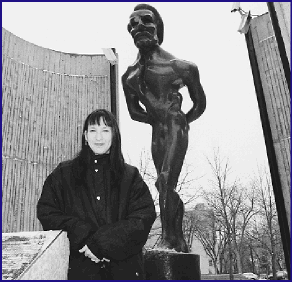
    |
 |
|
by Barbara Black

Catherine Mattes stands in front of Marcien Lemay's statue of Riel. Once a focus of controversy on the Manitoba legislature grounds, it is now in front of Collège St-Boniface.
Catherine Mattes, a recent MA in Art History, is making a little history of her own tomorrow. She will be the first Concordia valedictorian from the Art History Department, and her thesis supervisor, Professor Joan Acland, couldn't be happier.
"She's a wonderful young woman," Acland said. "Catherine is committed to providing a revised history of First Nations in Canada."
As well as being active in Concordia's Native Education Centre, Mattes assisted Acland in a major research project on the Web, and helped organize a conference on First Nations art and architecture last spring, when Douglas Cardinal came to receive an honorary degree.
In fact, in 1997, Mattes won a National Aboriginal Achievement Award (formerly the Canadian Native Arts Foundation). An important part of that recognition was the work she was doing here -- and presenting across Canada at conferences -- on a most controversial figure in Canadian history, Louis Riel.
Her Master's thesis is called Whose Hero? Images of Louis Riel in Contemporary Art and Métis Nationhood. It's a determined effort to get past the controversy and mythology that have swirled around the Métis leader for more than a century.
Mattes examines the complex reactions, especially of the Métis themselves, to the growing stature of Riel as a statesman, and to the often hotly contested efforts to portray him in works of public art.
A modernist 1971 statue by Marcien Lemay that showed Riel as a naked, tortured figure enflamed Manitobans for the entire 23 years that it stood on the grounds of the majestic legislative building in Winnipeg. When lobbying by a Métis group persuaded the provincial government to remove it, the artist and another supporter chained themselves to the statue.
A similar statue -- and a similar controversy -- erupted on the grounds of Saskatchewan's provincial legislature. The lesson Mattes draws in her thesis is that representations of Riel, whether as a tortured soul, an oppressed rebel or a distinguished statesman, are of central importance to the Métis community's sense of themselves.
"The first question Métis people ask me about my thesis is, How did you define us?" Mattes said in a phone interview from Winnipeg last week.
It's a tough question, she admitted. In Quebec, "Métis" is often used to mean anyone of mixed aboriginal and European ancestry, but in the Prairies, it tends to mean those descended from the Métis nation that flourished there in the 19th century.
A few facts will show how significant this group once was. In 1870, on the Canadian Prairies, there were between 10,000 and 12,000 Métis, 35,000 First Nations people, and fewer than 2,000 white settlers.
The year before, the Hudson's Bay Company sold the Prairies (yes, the whole thing) to the new Canadian government. By 1883, enough whites had flooded in to outnumber the aboriginals; that and the over-hunting of the buffalo spelled the end of their nomadic way of life.
The Métis, who had effectively bridged the cultures, began an agonizing downward slide that ended in rebellion, bloodshed and the execution for treason in 1885 of their charismatic leader, Riel.
Mattes has always considered herself Métis. Her mother is aboriginal on both sides, with some Métis roots; her father is non-native. Some people interpret Métis less strictly than others. "There's a relaxed attitude," Mattes said. "For example, my fiancé, who isn't Métis, is accepted at Métis events."
For now, Mattes is taking a breather from her studies by helping her family with their business; her father instructs operators in First Nations communities how to operate and maintain their water and waste-water plants.
However, she is doing intensive research on her own genealogy. She also hopes for a grant to create a multimedia exhibit based on her Riel thesis at the Winnipeg Art Gallery -- an exhibit which will have the active participation of the Métis community.



